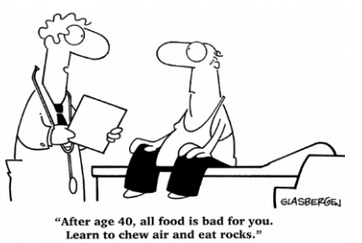NUTRITION & THE OLDER ADULT
Body composition changes as people get older. One of the noteworthy alterations is the reduction in total body protein. A decrease in skeletal muscle is the most noticeable manifestation of this change but there is also a reduction in other proteins such as organ tissue, blood components, and immune bodies as well as declines in total body potassium and water. This contributes to impaired wound healing, loss of skin elasticity, and an inability to fight infection.
Although energy expenditure decreases with age, protein intake should not be reduced. Protein is essential in the maintenance of muscle and bone. The recommended dietary allowance (RDA) (The World Health Organisation) for adults for protein is 0.8 grams of protein per kilogram of body weight.
Protein tissue accounts for 30% of whole-body protein turnover but that rate declines to 20% or less by age 70. The result of this phenomenon is that older adults require more protein/kilogram body weight than do younger adults.
Whilst total energy consumption may be less for the older adult if activity levels are declining, this reduction in calories should occur in consuming less carbohydrates i.e. bread, pasta, cereals, not the reduction of protein. At the age of 70, protein requirements actually increase and it is suggested that at least 1.2g of protein per kilogram of body weight be consumed.
The changing needs of the aging body
Activity levels often decline for the elderly and the requirements for specific nutrition varies for those who suffering diseases particularly those that effect gastrointestinal tract absorption of specific nutrients. The prescription of multiple medications may also adversely influence absorption.
Calcium, phosphorus, magnesium, iron, zinc, selenium, Vitamin A, B and C do not change significantly, however Vitamin D is recommended to be 400iu per day (compared to 5iu in younger adults).
Increased Fracture Risk in Older Adults
One in two women over the age of 50, and one in five men will sustain a fracture in their lifetime. The common fracture to affect those aged 50 are fractures of the forearm, at age 60-vertebral fractures and at age 70 - hip fractures. Twenty-percent of people die in the first year following hip fracture, 30% are permanently disabled and 40% are never able to walk again.
Under nutrition is associated with bone fragility – resulting in increased fracture risk and delayed fracture repair. Protein supplementation has shown to have a positive effect on vertebral BMD, and shorter hospital stay following fracture. In fact, he risk of hip fracture is inversely proportional to protein intake.
Protein intake is an important determinant of muscle mass and function. Studies in elderly populations display that protein consumption of 0.7g/kg can actually result in muscle loss. Encouragingly, this study reflected that those participants consuming enough protein to be in nitrogen balance are able to experienced muscle gain.
The importance of dietary protein cannot be underestimated in the diets of older adults; inadequate protein intake contributes to a decrease in reserve capacity, increased skin fragility, decreased immune function, poorer healing, and longer recuperation from illness.
Nutrient Reference Values for Australia and New Zealand- Australian Government National Health and Medical Research Council Fracture Risk in Older Adults
RDI
Men
19-30 yr 52 g/day (0.68 g/kg) 64 g/day (0.84 g/kg)
31-50 yr 52 g/day (0.68 g/kg) 64 g/day (0.84 g/kg)
51-70 yr 52 g/day (0.68 g/kg) 64 g/day (0.84 g/kg)
>70 yr 65 g/day (0.86 g/kg) 81g/day (1.07 g/kg)
Women
19-30 yr 37 g/day (0.60 g/kg) 46 g/day (0.75 g/kg)
31-50 yr 37 g/day (0.60 g/kg) 46 g/day (0.75 g/kg)
51-70 yr 37 g/day (0.60 g/kg) 46 g/day (0.75 g/kg)
>70 yr 46 g/day (0.75 g/kg) 57 g/day (0.94 g/kg)
